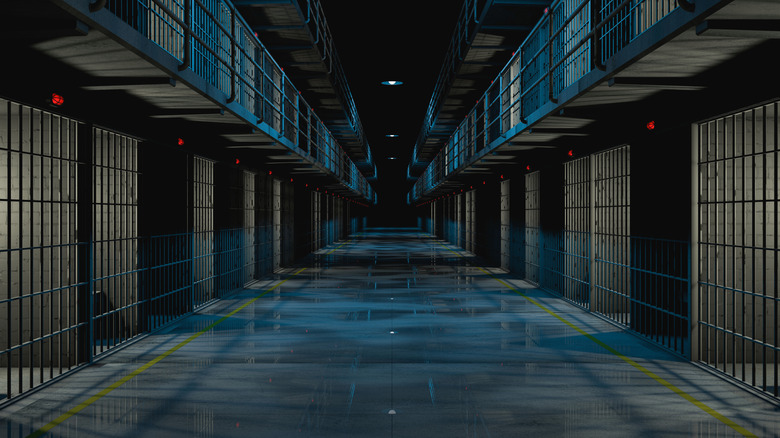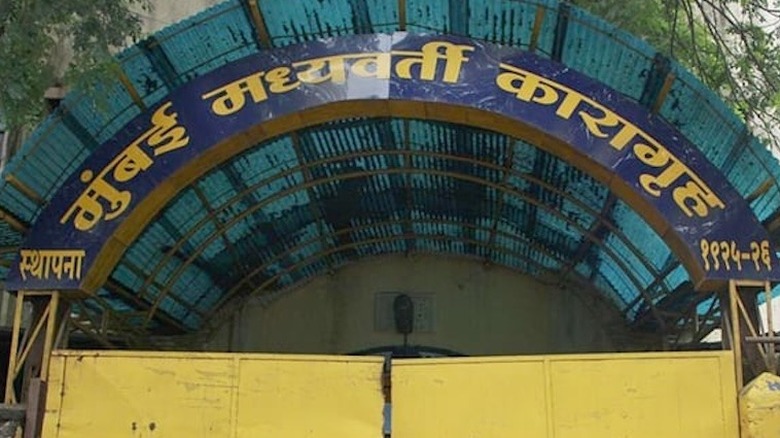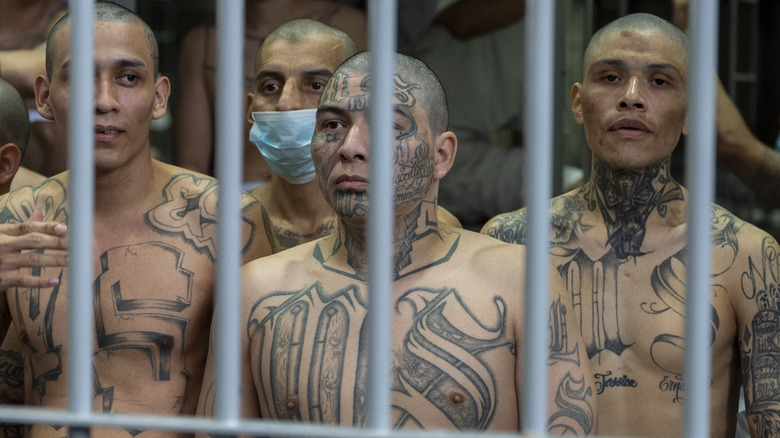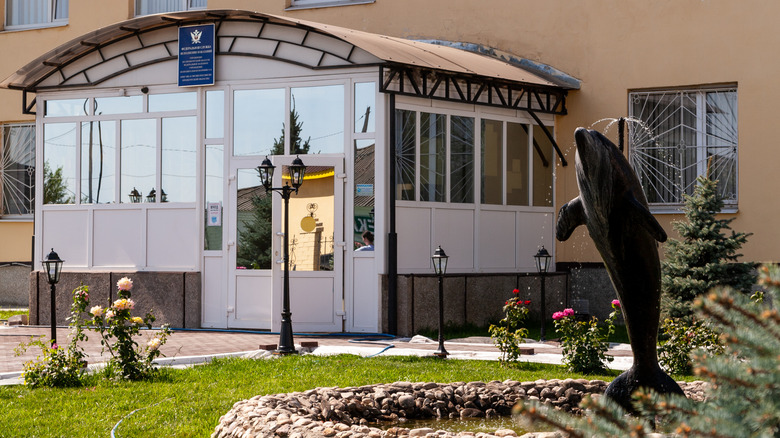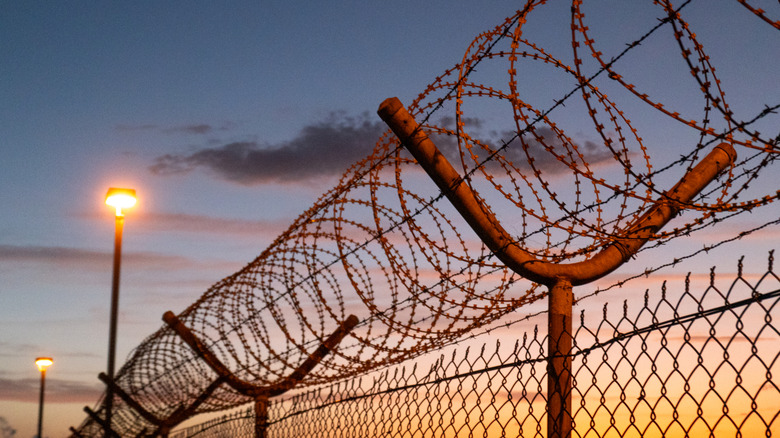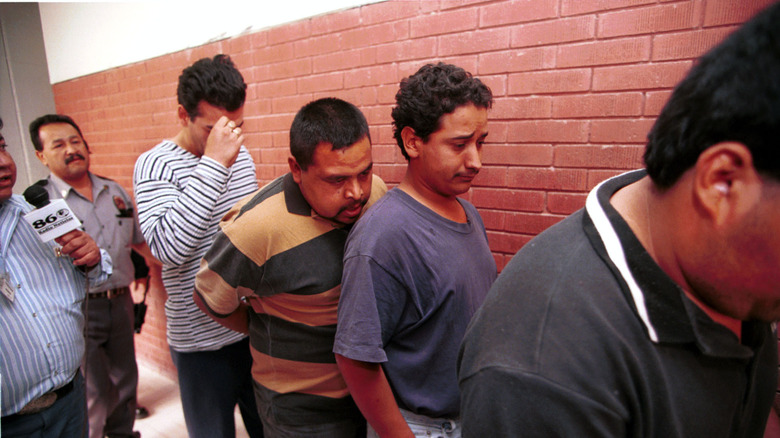Doing Time In These Prisons Is Practically A Death Sentence
Prisons — sometimes called reeducation, readaptation, or corrections centers — are purpose-built and intended to house convicted criminals for months, years, or even for the rest of their natural-born lives, or until their capital punishment. They're generally supposed to be unpleasant, if not brutal. Criminals are there because they've been deemed a danger to society or an adversarial government, and the denial of freedom is supposed to be their punishment.
Some facilities are worse than others. Following weird and obscure prison rules can make for a highly regimented day-to-day existence that's boring and tedious. Meanwhile, the maximum security facilities are populated with such violent and fearsome convicts that the brutal staff often dole out excruciating punishments. The worst prisons, home to everyone from modern-day killers to people simply awaiting trial, take away not just freedom but also basic rights and dignity. Here's a look behind the walls and into the cells of the prisons around the world thought to be so dangerous and frightening that a sentence there could mean a fate almost as bad as death.
Camp 14, North Korea
The audaciously strict and retaliatory totalitarian government of North Korea operates a series of prisons it classifies as reeducation facilities. These are actually hard labor camps, where days filled with tedious and grinding physical work and indoctrination into government ideology are the proposed "cures" for criminal activity. Those inmates eventually see release, but those who are sent to a "total control zone" don't. One such facility is the particularly well-populated and physically large Camp 14. What's known about the facility comes from the few people who have ever been inside that made it out alive, like Shin Dong-hyuk, who was born into an incarcerated family there and escaped at the age of 23.
According to Shin, order at Camp 14 is maintained through a combination of fear, immediate and severe consequences, and a long list of rules. One of those rules is to report anyone seen violating any regulation, which encourages the inmates — even family members — to turn on each other. Those suspected of violations may disappear from the general areas for days to be tortured with fire, and public executions are a regular occurrence. Guards must follow orders to hurt and kill prisoners, but they're also able to act of their own accord, and they willingly and frequently beat, kill, and sexually assault the inmates.
San Pedro, Bolivia
It began as a progressive experiment in the name of prison reform. But San Pedro, a facility in the Bolivian capital city of La Paz, quickly evolved into a harrowing and overpopulated mini-society characterized by a crushing and exploitative class system. San Pedro was built to accommodate about 600 people, specifically families, operating under the idea that it's harmful to separate convicted criminals from their spouses and children. Instead, San Pedro became an enclosed and restricted city of 3,000 residents where the innocent are also prisoners and subject to the same abuse and horrors as those actually doing time.
An all-powerful dictator-like figure rules over San Pedro, and he's an inmate who's also head of a delegate council that sends out a military-like police unit called "Disciplina" to enforce its ways. The "haves" live in a nicer and safer part of the prison and enjoy access to luxuries like personal bathrooms and cable television, far from the inmates who pay them rent — obtained from their low-wage work on the grounds — to live in their cells. The elite also make money by running San Pedro's marijuana and cocaine trades. There are guards at San Pedro, but they're powerless in the wake of the council — they patrol the perimeter and spring into action only to quell riots.
ADX Florence, US
After Ted Kaczynski, the Unabomber, was caught, he spent most of the rest of his life at ADX Florence, a supermax federal prison in rural Colorado. It's also the current site of El Chapo's prison cell — the drug kingpin was relocated here after he was recaptured following an escape from a Mexican prison. Both of those individuals met the criteria for incarceration at ADX Florence, built to hold the biggest threats to American security and safety. Referred to as the "Alcatraz of the Rockies," the prison has never experienced a breakout.
Inmates barely have the chance to speak with one another and have almost no communication with guards. That's mostly because ADX Florence is in constant lockdown status, with prisoners spending 23 hours of every day in their soundproof, 84-square-foot cells. Each one is outfitted with a desk, bunk, shelf, and stool, all concrete, and a steel toilet and sink. There's a window at chest level, and it's 4 inches wide and looks out onto an empty landscape. Prisoners pass the time sleeping as best they can (when they're not coping with insomnia and claustrophobia), as well as reading, exercising in place, and writing with crayon-sized rubber pens that can't be weaponized.
Arthur Road Jail, India
As of 2025, the urban-set Arthur Road Jail in Mumbai, a facility built to contain 999 prisoners, is the present home of more than 3,400 inmates. Many are only in the facility because they've been arraigned and are facing trial. In some of the barracks, around 250 people may reside in spaces designed for 49, with residents stealing beds from each other when someone leaves to use the restroom, which are by and large kept in an unsanitary state. Otherwise, the men sleep on the floor, jammed up against one another.
Prisoners are reportedly barely fed at Arthur Road Jail — they get just one meal consisting of a spoonful of lentils and uncooked rice suspended in tepid water. The one pleasure inmates are allowed is smoking, which causes its own set of problems. Prisoners routinely burn their feet on the discarded cigarette butts found all over the prison's grounds, and there's a constant cloud of smoke hanging in the air. While Arthur Road Jail inmates often break out in violent fights, their alleged treatment by the guards is even worse — skirmishes are quelled with force. In 2021, two cellmates were fighting, and to stop it, multiple prison officers attacked the entire cell, injuring 40 people with wooden poles and razors.
Zahedan Central Prison, Iran
In the middle of Zahedan, Iran, stands Zahedan Central Prison, where three to five prisoners occupy one-person cells. The facility is only built to house a few hundred inmates, but it holds over 2,000. Eight of its wards are for a general population of inmates, while Ward 9 holds only political prisoners and is operated without oversight by the city's intelligence department.
In Ward 9, protesters and enemies of the ruling party receive the staff's cruelest treatment, including multiple kinds of torture. Inmates are regularly subjected to sleep and food deprivation and forced to endure cold as a form of punishment. Those who try to protest political issues or their own mistreatment with hunger strikes are forced to quit by guards who chain them up and beat them with pipes and batons. Residents who misbehave the most are sent to solitary confinement for long periods of time in cells overrun with insects, where they're denied light and the use of restroom facilities.
In 2022, the U.S. Treasury Department's Office of Foreign Assets Control called out and sanctioned wardens past and present of Zahedan Prison for their excessively violent and politically targeted behavior. That included multiple executions at their discretion against members of the Baluchi, an ethnic minority in Iran, as well as torture of prisoners, general mistreatment, and denial of medical care.
CECOT, El Salvador
Some of the world's most dangerous gangs are held in the Center for Terrorism Confinement (CECOT). MS-13 and Barrio 18 have long controlled the drug trade in El Salvador, and after an uptick in violence in 2022, the federal government captured all the gang members it could and locked them up together, many without trial, in the purpose-built prison. The isolated, jungle-set facility is also the place where El Salvador sends its most egregious criminal offenders, including murderers of all kinds, where coerced confessions and 200-year sentences are normal.
With a capacity of 40,000, CECOT is half full as of 2025, but men are still crowded into cells living in an environment that human rights groups have accused of being overly harsh and undignified. Subsisting on a diet in which meat is banned, inmates eat beans or pasta, and that's about it. They leave their multiple-occupancy cells for a maximum of 30 minutes a day, only to go to a video link-up room for a hearing or to exercise in a hallway. They shower in their cells and drink water from a plastic collection barrel and are watched over 24 hours a day via closed-circuit TV cameras as well as a collective of 1,000 guards, 600 troops, and 250 riot police. No visitors are allowed, and residents of the largest prison in Latin America endure sleep deprivation as they try to rest on steel beds with no mattresses provided.
Manila City Jail, the Philippines
Manila City Jail is a very modest facility, designed to hold 170 inmates in the capital of the Philippines. Instead, more than 500 prisoners are crowded in its walls, meaning every spare surface is used as a sleeping spot. As many as six men may rest each night in a stairwell or in a cell's bathroom atop cardboard on tile floors wet with water runoff from malfunctioning equipment. The jail is reportedly so hot, humid, and poorly ventilated that the air feels heavy.
The tightly packed prison — named one of the most crowded on the planet by the World Prison Brief — is the direct result of a government push to arrest drug offenders. Moving up out of the crushing crowds is a possibility for inmates with money — they can buy their way into a "kubol," a relatively wide-open plywood cubicle occupied by just a couple of people. Day-to-day life is especially tough for captives because the vast majority of those held inside Manila City Jail aren't convicts — it's a jail, not a prison, so these are people accused of crimes awaiting trial. If found guilty, they'll have more time behind bars, in an actual prison, in front of them.
Black Dolphin Prison, Russia
If convicted of the most reprehensible crimes in Russia, it's likely that the criminal will be sent to serve their life sentence at Black Dolphin Prison, located in the Orenburg Oblast in the southwest part of the country. Seemingly every aspect of life at the facility — named for the prisoner-made sculpture of the curiously free sea creature outside the entrance — is designed to sap the prisoner of energy, dignity, and any inner resolve. Inmates live two to a cell (although the most violent offenders get their own), kept behind multiple sets of heavy doors to ensure security.
Cellmates are forbidden from communicating beyond stopping each other from trying to escape. They're kept inside those tiny rooms for most of the day, and they're required to spend 16 hours on their feet, leaving only for a little bit of exercise, at the guards' discretion, in a steel mesh room. The facility is monitored by 24-hour camera surveillance and rounds every 15 minutes. During exercise breaks, guards search cells for forbidden materials.
Black Dolphin prisoners are meant to feel constantly tired and listless. They're fed only with enough soup to provide the low end of basic nutrition, and the central heating system works just enough to sustain bare comfort. Guards add to the sense of futile resistance by transferring prisoners only when they're blindfolded, handcuffed behind their backs, and bent at the waist. Any response beyond "Yes, sir" can result in severe punishment.
Black Beach Central Prison, Equatorial Guinea
Dug out of a hole in the ground near the sea and without much substantial infrastructure, Black Beach Central Prison in Equatorial Guinea is so hot and humid as to be unbearable most of the time. It houses around 800 prisoners, and only about two-thirds of them have actually been convicted of a crime in a court of law. The remainder are sent to the prison if they're arrested for small crimes and aren't able to bribe police officers — or at the pleasure of corrupt government officials of opposing ideology. Prisoners may find themselves awaiting trial for several years from inside the walls of Black Beach Central Prison. Regardless of their judicial status, inmates moving into the Baghdad unit for women or the Djibolo unit for men are savagely beaten by guards as part of a violent initiation trial.
The very poor sanitation at Black Beach Central Prison results in frequent outbreaks of illness. Two poorly maintained washrooms service the entire prison population, while toilets in cells are there for eliminating personal waste. They lack running water, however, and that, combined with food that's been described as rotten and inedible, leads to common breakouts of diarrhea. In 2019, nine prisoners died in one such upsurge, and the bodies were left in the cells for hours. Sleep doesn't offer much solace, either. No beds are provided, so residents sleep on scrap cardboard laid out atop sharp, meshed metal floors.
Bang Kwang Central Prison, Thailand
In the midst of Bangkok stands Bang Kwang Central Prison, ironically nicknamed the Bangkok Hilton. At any given time, it's home to 6,000 inmates, serving sentences of at least 33⅓ years, if not the death penalty for crimes that merit it. Executions, regularly carried out on the 500 or so death row inmates, take place in an on-site chamber — prisoners die by lethal injection or three bursts of nine machine gun blasts, an act that's audible all over the Bang Kwang grounds.
Upon entry into Bang Kwang, inmates are forced to wear irons on their legs for their first three months, while some of the more egregious offenders once wore them for the duration of their sentence. It's so overcrowded that as many as 12 prisoners may occupy a cell that's just 120 square feet, where they easily spread infections due to the squalid conditions made worse by germ-infested tap water, bedbugs, and roaches. Everyone eats once a day, and it's an extra-small portion of something like rice and vegetables mixed with rocks.
The threat of death is constant at Bang Kwang — untreated HIV runs rampant at the facility, spread by the prison's heroin users. Bang Kwang is so hopelessly crowded that the prisoners are essentially free to do whatever they want, including buying, selling, and using drugs. They also run a casino, and unpaid debts are met with knife and crowbar attacks — and that's just from other prisoners. Overwhelmed guards routinely dole out near-fatal beatings.
Cereso No. 3, Mexico
Cereso No. 3 is a state prison in the Mexican city of Juarez, just over the border from the United States and the headquarters of the powerful and cutthroat Juarez Cartel that smuggles large quantities of drugs. That organization has so much authority and manpower in Juarez that Cereso No. 3 has frequently endured its wrath, making for a prison experience beset by violence and fear.
On January 1, 2023, armed affiliates associated with the cartel stormed the prison to facilitate the escape of leader Ernesto "El Neto" Pinon de la Cruz. A total of 30 inmates escaped, but in the standoff, three prison guards and seven inmates were shot to death. Then in August 2024, in-fighting among incarcerated members of the rival Sinaloa Cartel led to a broader fight carried out with homemade knives that resulted in seven seriously wounded individuals. In 2025, seemingly to prevent one of the most violent prison riots ever or something similar from taking place, 120 inmates, all members of the Doblados gang, were moved out of Cereso No. 3. Worried about the threat posed to the authority and safety of the guards and other inmates, it took 400 uniformed service personnel to make the transfer.
